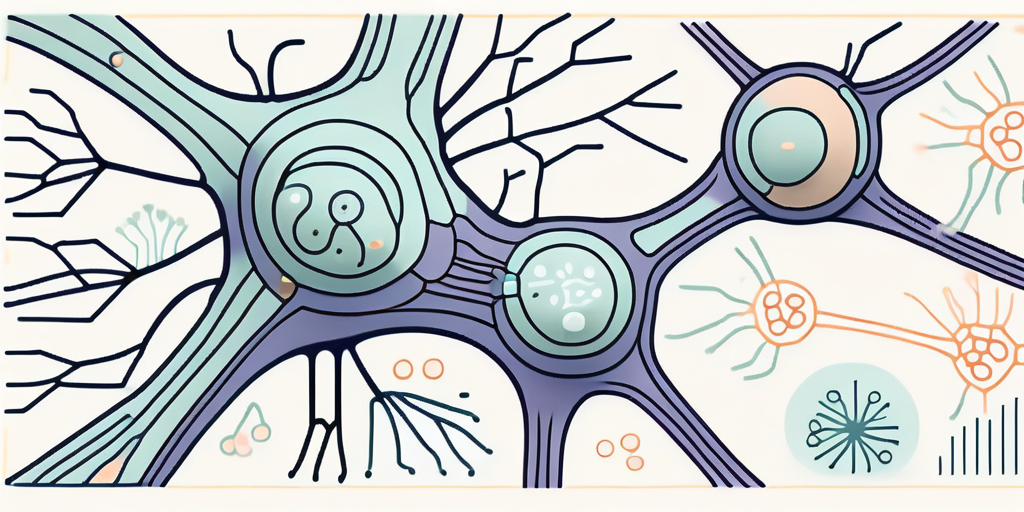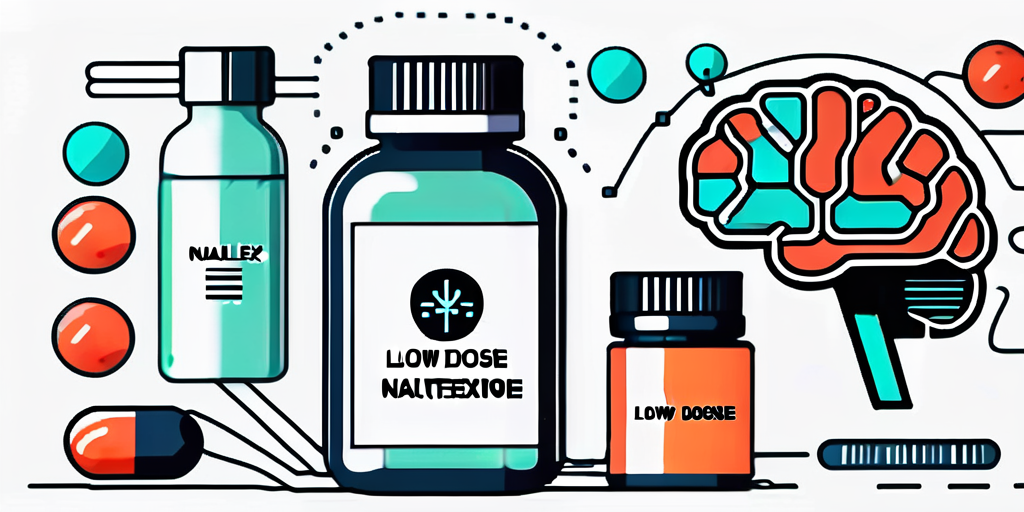Fibromyalgia is a chronic condition that affects millions of people worldwide. It is characterized by widespread musculoskeletal pain, fatigue, and tenderness. In this article, we will explore the benefits of using low dose naltrexone (LDN) as a treatment for fibromyalgia.
Understanding Fibromyalgia
Fibromyalgia is a chronic disorder characterized by widespread pain, fatigue, sleep disturbances, cognitive difficulties, and mood swings. It affects millions of people worldwide, predominantly women. Despite its prevalence, diagnosing fibromyalgia can be challenging due to the lack of specific diagnostic tests. However, doctors rely on a combination of symptoms to make a proper diagnosis.

Symptoms and Diagnosis of Fibromyalgia
One of the main challenges in diagnosing fibromyalgia is the lack of specific diagnostic tests. However, doctors consider a combination of symptoms to make a proper diagnosis. Common symptoms include widespread pain, fatigue, sleep disturbances, cognitive difficulties, and mood swings.
Widespread pain is a hallmark symptom of fibromyalgia. It is characterized by aching, burning, or throbbing pain that is present in multiple areas of the body. This pain can range from mild to severe and can be accompanied by stiffness and tenderness in the muscles and joints.
Fatigue is another common symptom experienced by individuals with fibromyalgia. It is not just a feeling of tiredness, but a persistent lack of energy that can significantly impact daily activities. Sleep disturbances, such as insomnia or non-restorative sleep, are often associated with fibromyalgia and can contribute to the fatigue experienced by patients.
In addition to physical symptoms, fibromyalgia can also affect cognitive function. Many individuals with fibromyalgia experience difficulties with memory, concentration, and attention span. This cognitive fog, often referred to as “fibro fog,” can make it challenging to perform tasks that require mental focus and can impact work, school, and daily life.
Mood swings are another common symptom of fibromyalgia. Many individuals with fibromyalgia experience changes in mood, ranging from irritability and anxiety to depression. These mood swings can be attributed to the chronic pain, fatigue, and other symptoms associated with the condition.
It is important to note that fibromyalgia symptoms can vary in severity from person to person. Some individuals may experience mild symptoms that are manageable, while others may struggle with severe pain and fatigue on a daily basis.
Common Treatments for Fibromyalgia
The management of fibromyalgia often involves a multifaceted approach. Treatment options may include medication, physical therapy, exercise, stress reduction techniques, and lifestyle changes. However, finding an effective treatment plan can be challenging, as fibromyalgia is a complex condition that affects individuals differently.
Medication is commonly used to manage the symptoms of fibromyalgia. Pain relievers, such as nonsteroidal anti-inflammatory drugs (NSAIDs) and opioids, may be prescribed to help alleviate pain. Antidepressants and anticonvulsants are also sometimes used to address the mood and sleep disturbances associated with fibromyalgia.
Physical therapy can be beneficial for individuals with fibromyalgia. It involves exercises and techniques aimed at improving strength, flexibility, and overall physical function. Physical therapists can also provide guidance on proper body mechanics and ergonomics to minimize pain and prevent further injury.
Regular exercise is an important component of managing fibromyalgia. Low-impact activities, such as walking, swimming, and yoga, can help improve muscle strength, reduce pain, and enhance overall well-being. It is essential to start slowly and gradually increase the intensity and duration of exercise to avoid exacerbating symptoms.
Stress reduction techniques, such as relaxation exercises, meditation, and deep breathing, can help individuals with fibromyalgia manage their symptoms. Stress can worsen pain and fatigue, so finding effective strategies to cope with stress is crucial in improving quality of life.
Lifestyle changes, such as maintaining a healthy diet, getting enough sleep, and establishing a regular sleep routine, can also play a significant role in managing fibromyalgia symptoms. Avoiding triggers, such as certain foods or activities that worsen symptoms, can help individuals better manage their condition.
In conclusion, fibromyalgia is a complex condition that affects individuals differently. Diagnosing fibromyalgia relies on a combination of symptoms, as there are no specific diagnostic tests. The management of fibromyalgia often involves a multifaceted approach, including medication, physical therapy, exercise, stress reduction techniques, and lifestyle changes. By addressing the various aspects of the condition, individuals with fibromyalgia can find relief and improve their overall quality of life.
Introduction to Low Dose Naltrexone
Low Dose Naltrexone (LDN) is a treatment that has gained significant attention in recent years for its potential benefits in managing chronic conditions, such as fibromyalgia. To understand LDN, it is important to first explore the medication it is derived from – naltrexone.

What is Naltrexone?
Naltrexone is a medication that was initially developed to help individuals overcome substance abuse issues. It works by blocking the effects of opioids in the brain, thus reducing the desire to use opioids or alcohol. By binding to opioid receptors, naltrexone prevents the euphoric effects of opioids, making it an effective tool in addiction treatment.
However, researchers soon discovered that naltrexone had potential benefits beyond addiction treatment. This led to the exploration of low dose naltrexone and its effects on various chronic conditions.
The Concept of Low Dose
The concept behind low dose naltrexone is intriguing. While the standard dose of naltrexone used for addiction treatment is around 50mg, low dose naltrexone refers to the use of a much lower dose, typically ranging from 1.5mg to 4.5mg.
At these lower doses, naltrexone is believed to have a different mechanism of action. Rather than blocking opioid receptors completely, low dose naltrexone is thought to modulate the immune system and increase the production of endorphins – the body’s natural painkillers.
Endorphins play a crucial role in pain management, mood regulation, and overall well-being. By increasing endorphin production, LDN may help alleviate pain, improve sleep quality, and enhance the overall quality of life for individuals with fibromyalgia and other chronic conditions.
It is important to note that the use of low dose naltrexone as an off-label treatment is still being researched and its effectiveness may vary from person to person. However, the growing interest in LDN and the positive anecdotal reports from patients have sparked curiosity and hope among those seeking alternative treatment options.
In conclusion, low dose naltrexone offers a potential avenue for managing chronic conditions like fibromyalgia. By modulating the immune system and increasing endorphin production, LDN may provide relief from pain and improve overall well-being. However, further research is needed to fully understand its mechanisms and effectiveness.
How Low Dose Naltrexone Works for Fibromyalgia
The Science Behind Naltrexone and Fibromyalgia
Research has shown that LDN can modulate the immune system and reduce inflammation. In fibromyalgia, there is evidence to suggest that the immune system is overactive, leading to increased pain sensitivity and other symptoms.
By regulating immune responses, LDN may help rebalance the immune system, leading to a reduction in symptoms for individuals with fibromyalgia.
The Role of Endorphins and Immune System
Endorphins are natural chemicals produced by our body that help reduce pain and make us feel good. In fibromyalgia, there is a deficiency in endorphin production, which can contribute to the chronic pain experienced by individuals.
LDN works by increasing endorphin levels, which in turn can help alleviate pain and improve mood for individuals with fibromyalgia. By modulating the immune system and boosting endorphins, LDN offers a unique approach to managing this complex condition.
Potential Benefits of Low Dose Naltrexone
Pain Management and Reduction
One of the key benefits of LDN for fibromyalgia is its potential to reduce pain levels. Many individuals have reported a decrease in pain intensity and an increase in pain tolerance after starting LDN treatment.
By addressing the underlying immune system abnormalities and boosting endorphin production, LDN may provide significant relief for individuals with fibromyalgia.
Improved Sleep and Mood
Sleep disturbances and mood disorders are commonly associated with fibromyalgia. LDN has shown promise in improving sleep quality and promoting a more restful night’s sleep for individuals with fibromyalgia.
In addition, LDN may also have a positive effect on mood and help reduce anxiety and depression, which are often comorbid conditions in individuals with fibromyalgia.
Enhanced General Well-being
Individuals who have incorporated LDN into their fibromyalgia treatment plan have reported an overall improvement in their well-being. This includes increased energy levels, better cognitive function, and a decreased reliance on pain medications.
By addressing the root causes of fibromyalgia symptoms, LDN may provide individuals with a more holistic approach to managing their condition, leading to improved quality of life.
Side Effects and Risks of Low Dose Naltrexone
Common Side Effects
Like any medication, LDN may have side effects. However, they are typically mild and transient. The most commonly reported side effects include nausea, dizziness, headache, and sleep disturbances.
It is important to note that individual reactions to LDN may vary, and it is advisable to consult with a healthcare provider before starting any new medication.
Long-term Risks
As LDN is a relatively new off-label treatment for fibromyalgia, there is limited long-term data on its safety and efficacy. Further research is needed to fully understand the potential risks and benefits of using LDN as a long-term treatment for fibromyalgia.
It is advisable to work closely with a healthcare provider and regularly monitor any potential side effects or changes in symptoms while using LDN as a fibromyalgia treatment.
Conclusion
Low dose naltrexone holds promise as a potential treatment option for individuals with fibromyalgia. By modulating the immune system, boosting endorphin production, and addressing the underlying abnormalities, LDN offers a unique approach to managing this complex condition.

However, it is important to consult with a healthcare provider to determine if LDN is a suitable treatment option for you and to discuss any potential risks or side effects. With further research, LDN may become a valuable addition to the treatment options available for fibromyalgia, offering improved pain management, better sleep, and enhanced overall well-being.


